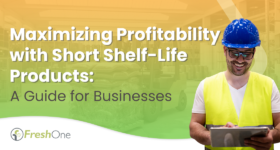Businesses frequently need help managing items with short shelf-life in today’s fast-paced market. These products often have short shelf-lives due to perishability or expiration dates.
However, even with things that have a short shelf-life, firms can still efficiently optimize profits with the appropriate methods and careful preparation.
We’ll discuss various inventory management techniques in this post to assist you in improving your supply chain, cutting expenses, and boosting customer satisfaction.
What Is a Short Shelf-Life Product?
A product with a short shelf-life has a specific time before it loses its suitability for use or consumption. Several elements, such as the product’s perishability, susceptibility to decomposition, or expiration dates, affect the shelf life.
Short shelf-life products like perishable foods, medicines, and cosmetics can spoil before expiration due to bacterial growth, chemical reactions, deterioration, potency loss, or changes in quality that render them unfit for their intended use.
Strategies for Better Shelf-Life Management
- Efficient Inventory Management
Managing inventory effectively is essential when working with products with a limited shelf-life. Businesses should have a reliable tracking system to keep track of the quantity and expiration dates of perishable commodities.
To prevent potential losses due to expiration, they can identify slow-moving items and take preemptive measures, such as providing discounts or promotions.
- Demand Forecasting and Planning
The key to maximizing profitability for short shelf-life products is accurate demand forecasting. Businesses can forecast demand patterns and modify their production and procurement by studying past sales data, market trends, and seasonal fluctuations.
By implementing a demand planning system, waste may be minimized, and the possibility of overstocking or understocking can be decreased.
- Streamlined Supply Chain
An organized and effective supply chain is essential for companies with short shelf-life items. Just-in-time (JIT) inventory policies and good supplier connections can help to cut lead times and lower the danger of carrying too much inventory.
Utilizing automation and technology in logistics can also boost overall effectiveness and ensure timely deliveries.
- Effective Product Packaging
Perishable commodities must be appropriately packaged to maintain freshness and increase shelf life. Spending money on packaging materials that preserve product quality and lower spoilage can dramatically impact profitability.
Additionally, precise, and unambiguous labeling with expiration dates and storage instructions can assist customers in making knowledgeable choices and lessen the possibility of customer discontent after the sale.
- Data Analysis and Continuous Improvement
Continuous improvement relies on using data analysis and input from customers and suppliers. Monitoring client preferences, sales trends, and comments can help find opportunities for improvement and innovation.
By leveraging technology-driven analytics solutions, businesses can get insightful information and make data-driven decisions to enhance revenue with short shelf-life products.
FreshOne is a trusted partner specializing in refrigerated, frozen, and short shelf-life products. With expertise in the food industry and a strong emphasis on food safety, we offer reliable, experienced solutions for businesses managing short-shelf-life products, optimizing operations, minimizing waste, and ensuring food safety.
Our comprehensive capabilities and industry knowledge make us the trusted partner for businesses looking to maximize profitability with short shelf-life products.

